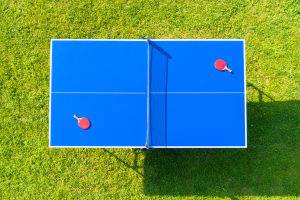
Table tennis, commonly known as ping pong, is one of the most popular indoor sports globally. Played in almost every country, it is not only a fun activity but also a competitive sport with rigorous international standards.
In this article, we will walk through the essential aspects of table tennis, from its equipment and rules to the layout of the playing field.
Basic Equipment and Playing Field
To start playing table tennis, we need specific equipment: the ball, table, racket, and the net. The standard table tennis ball is a hollow plastic ball with a diameter of 40mm and a weight of 2.7 grams. It’s designed for high elasticity, allowing for fast-paced play.
The playing surface, or table, measures 2.74 meters in length and 1.525 meters in width, standing 76 cm tall. It's made from high-density fiberboard or similar materials, covered with a smooth, low-friction coating for optimal performance. A net, which stands 15.25 cm high, divides the table into two equal parts.
Rules of the Game
The game starts with a serve, where the player must throw the ball vertically at least 16 cm in the air before striking it. The ball must first land on the server’s side of the table, pass over the net, and then land on the opponent’s side. Players alternate hitting the ball back and forth until one fails to return it, at which point the opponent scores a point.
A typical match follows a best-of-five or best-of-seven format, with each game played to 11 points. The winner must lead by at least 2 points to win a game. This ensures competitive gameplay and excitement.
Changes in the Equipment Over Time
Table tennis equipment has evolved over the years. Early versions of the table were only 90 cm wide, and the net height was 17 cm. The International Table Tennis Federation (ITTF) later standardized these measurements. Another significant change occurred in 2014 when the ITTF switched to a new type of ball made from polyester, replacing the older, more flammable celluloid balls. This new ball has a slightly larger diameter, measuring between 40.00 mm and 40.60 mm, often marked as “40+,” helping to reduce ball speed and increase rally length.
Surface and Venue Requirements
The surface of the playing area must be made from wood or a type of plastic flooring approved by the ITTF. This flooring should be elastic to minimize the risk of slipping and should have no markings from other sports. The flooring color is usually dark red, and it must not reflect too much light to avoid distracting players.
For optimal conditions, the temperature in the venue should be between 20-25°C, and the airflow should not exceed 0.3 meters per second. These controlled environments ensure that the game is played fairly and safely.
Rackets and Rubber Types
The racket used in table tennis is made up of a wooden blade and rubber. The ITTF stipulates that at least 85% of the racket’s material must be natural wood, with possible reinforcement layers. These layers might include compressed paper or fiber material. There are different types of rackets, such as single-ply and multi-ply rackets, with the latter being more common due to its durability and flexibility.
Rackets can also be categorized by grip type. The two most common grips are the penhold and shakehand grips. The penhold grip is popular in Asian countries, especially China, while the shakehand grip is used more widely in Europe and among international professionals.
Types of Rubber
The rubber used on the racket also plays a significant role in a player’s performance. The ITTF limits the thickness of rubber layers to 4 mm, including any sponge underneath. The rubber can be classified into different types:
1. Inverted Rubber (Smooth): This type of rubber provides a greater surface area for generating spin.
2. Short Pips: These rubbers have larger, more spaced-out pips, allowing for less spin but faster ball speeds.
3. Long Pips: This rubber is used for defensive play, where the ball can be returned with unexpected spin.
4. Anti-spin: This rubber has a smooth surface with very little friction, making it useful for blocking fast shots.
Master the Game
We hope this guide has helped you understand the basics of table tennis, from the equipment to the playing rules and surfaces. Whether you’re playing casually with friends or competing professionally, understanding these elements can elevate your game. Table tennis is not only a test of skill but also of strategy and precision.
If you’re a fan of the game or just getting started, there’s always more to learn and improve. Happy playing, Lykkers! Stay tuned for more tips and tricks.
Basic Rules of Table Tennis – A Beginner’s Guide
video by PingSkills


